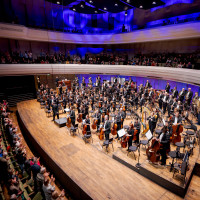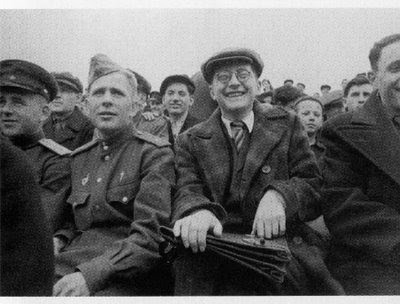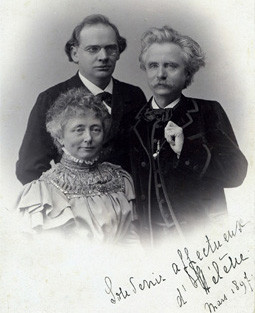Program Booklet
Shostakovich's Symphony No. 6
Friday , Oct. 10
20:15
hour until approximately 10:30 p.m.
Shostakovich's whimsical Sixth Symphony is a lesser-known work but reveals an endlessly intriguing world of melancholy, biting irony and unexpected exuberance.
📳
Please put your phone on silent and dim the screen so as not to disturb others during the concert. Taking photos is allowed during applause.
Programme
Prior to this concert there will be a Starter at 7:30 pm. A lively and casual program with live performances by our own musicians and interviews with soloists and conductors. The Starter is free of charge and will take place in the Swing Foyer opposite the cloakroom.
Max Knigge (1984)
Eliza May (2025, world premiere)
Brow Brown Hill
Sisters, play & characters
The post office
Haeger Mass
The loom
Eliza May by Max Knigge was made possible in part by Performing Arts Fund NL and Société Gavigniès.
Edvard Grieg (1843-1907)
Piano Concertoin a, op. 16 (1868)
Allegro molto moderato
Adagio
Allegro moderato molto e marcato - Quasi presto - Andante maestoso
At intermission we will serve a free drink.
Dmitri Shostakovich (1906-1975)
Symphony No. 6 in b, op. 54 (1939)
Largo
Allegro
Presto
What are you going to listen to?
Max Knigge
Opening tonight is the latest work by Dutch composer Max Knigge. Eliza May is named after the main character in the novel The Song of Stork and Dromedary by Anjet Daanje, the biggest literary hit of the Last years. Knigge sets several scenes from the book to music. Knigge: "I was completely captivated by the mysterious and fascinating world surrounding the character Eliza May Drayden. According to Knigge, the book "is about loneliness, sisters, role-playing in social interaction, gossip, the landscape of Yorkshire. And death is a connecting factor. Death as a concrete event, which certainly in the nineteenth century was a constantly looming presence. That is a dreary idea, but death is also the engine of existence, the event that puts life in perspective." Knigge wrote a suite, which consists of five movements but are played back-to-back, creating one movement. "Five is an important number in the book; it appears on almost every page. The parts include the hill that is heaven for Eliza May, the textile factory that stands opposite it as hell on earth and the post office where the villagers meet to gossip. I find the sketch of the village and its inhabitants, how people talk and think about each other and themselves, shaping their reality, one of the most fascinating aspects of the novel."
Edvard Grieg
Although it was recognized early on that Edvard Grieg possessed musical talent - he was taught piano and theory by his mother from the age of six - it was the famous Norwegian violinist Ole Bull who convinced Grieg's parents to let their fifteen-year-old son study at the Leipzig conservatory. During his first year of study in 1858, he heard Clara Schumann perform her late husband Robert's Piano Concerto. Deeply impressed, he decided to write a piano concerto himself although it was another ten years before Grieg put the plan into action. Meanwhile, he had been back in his homeland for some time where he had been profoundly influenced by Norwegian folk music. So too in his Piano Concerto whose final rondo is based on a well-known Norwegian folk dance, the "halling.
The 1869 premiere in Copenhagen was a great success, although Grieg, due to commitments elsewhere, did not play the solo part. He himself, however, was far from satisfied, and in the years that followed he revised the work no fewer than seven times, the Last only a few weeks before his death in 1907. The Piano Concerto ended up being the only solo concerto Grieg wrote. He did begin a second concerto in 1882, but left it at only a few sketches.
Dmitri Shostakovich
It was only barely a year ago that Dmitri Shostakovich had rehabilitated himself with his Fifth Symphony with the Soviet authorities, when he announced in the Journal of Literature that he planned to compose a vocal-instrumental symphony in memory of Lenin: "It is an incredibly difficult task to portray the titanic stature of the leader in music, and I am acutely aware of this. Therefore, when I talk about my symphony, I see that its basis is not in historical events or biographical facts, but very generally in the higher idea of the work. I have long been intensely concerned with the idea of how the stature of the leader can be expressed by musical means. I designed my symphony as a work for orchestra, chorus and soloists. I have carefully studied all the poetry and prose in honor of Vladimir Ilyich."
Repeatedly Shostakovich announced works he had no intention of writing at all, in order to gain time and work on something else in peace. In the years 1938-1939, he actually worked on the purely instrumental Sixth Symphony, which was completely overshadowed at the Festival of Soviet Music in Moscow by the success of Prokofiev's patriotic cantata "Alexander Nevsky. The Soviet authorities convened a meeting on the symphony immediately after its premiere on Nov. 5, 1939. Conductor Yevgeny Mravinsky was convinced though and performed the symphony repeatedly and so did Leopold Stokowski, who premiered the work abroad: "In each symphony, Shostakovich shows himself as a master who continuously develops his creative imagination and musical self-awareness. He reaches new heights in the Sixth Symphony, especially in the first movement, where the succession of harmonic and melodic turns acquires a special expressiveness and original timbre. At first hearing, these turns sound strange, perhaps even incomprehensible, as if they want to hide their meaning from us. On repeated listening, however, everything becomes clear, everything gains tremendous depth."
Prefer it on paper? Download a condensed printable version of this program.
Biographies

Residentie Orkest The Hague
-peter-brenkus.jpg/c9d3cc043aa51c847a817fd26d5ceb65.jpg)
Daniel Raiskin
.jpg/152d09fac862424bce5bbb1f02e0069b.jpg)
Antti Siirala
Fun Fact
Perfect Shostakovich
Shostakovich was a perfectionist. All the clocks in his apartment ran exactly the same and he tested the Russian postal service by regularly sending himself tickets . But he also loved soccer, and whenever possible, he sat in the stands at his favorite soccer club: Zenit Leningrad.

RO QUIZ
Has Grieg been to The Hague?-
Yes indeed
Right answer: yes
Edvard Grieg and his wife Nina frequented Amsterdam and The Hague and became friends with Dutch composer Julius Röntgen. Julius would even name one of his sons after the Norwegian composer. Edvard Röntgen was a cellist in the Residentie Orkest from 1924 to 1967.
-
Only in transit
Right answer: yes
Edvard Grieg and his wife Nina frequented Amsterdam and The Hague and became friends with Dutch composer Julius Röntgen. Julius would even name one of his sons after the Norwegian composer. Edvard Röntgen was a cellist in the Residentie Orkest from 1924 to 1967.
-
Well
Right answer: yes
Edvard Grieg and his wife Nina frequented Amsterdam and The Hague and became friends with Dutch composer Julius Röntgen. Julius would even name one of his sons after the Norwegian composer. Edvard Röntgen was a cellist in the Residentie Orkest from 1924 to 1967.

Right answer: yes
Edvard Grieg and his wife Nina frequented Amsterdam and The Hague and became friends with Dutch composer Julius Röntgen. Julius would even name one of his sons after the Norwegian composer. Edvard Röntgen was a cellist in the Residentie Orkest from 1924 to 1967.
Today in the orchestra
Help The Hague get music!
Support us and help reach and connect all residents of The Hague with our music.


View all program booklets
Be considerate of your neighbors and turn down your screen brightness.


